Oregon flower growers find a permaculture marketing niche
Walking into Pollinate Flowers’ backyard growing space feels like entering a storybook cottage garden. A long arbor draped with greenery leads the visitor down a shaded path to a deer-fenced permaculture production area.
Inside the gate, the gardens overflow with abundance. On either side of the central arbor run rows of tidy raised beds of perennials with reseeded annuals alongside gravel paths. Around the edges, naturally shaped borders of native perennial plants and trees obscure the perimeter fencing and create a soft feeling of enclosure.
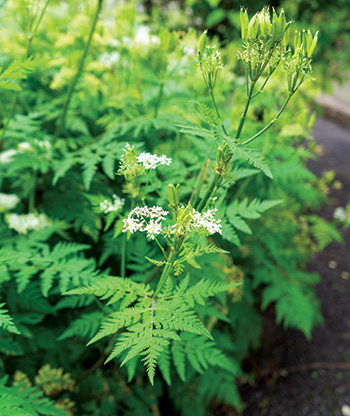
Sweet cecily is a Pacific Northwest native plant that Pollinate Flowers grows and harvests.
John Peterson and Jeremi Carroll bought this 2.5-acre parcel in 2012. At the time big sprawling lawns with a few trees and shrubs surrounded the house, making it look just like its neighboring rural residential properties outside of Dundee, Oregon. The married couple saw the potential for something entirely different and unique. Now, a decade later, over 1,000 established perennial plants fill the backyard ¾-acre garden with unexpected colors and textures. John and Jeremi are establishing another 1-acre garden at the front of their house, too.
I visited their farm twice earlier this year to interview John and see their flower operation in different stages of seasonal growth. The beauty of their spaces felt like something I’ve mostly experienced in home gardens. Being there made me want to pour lemonade and sit in the shade to watch bumblebees bounce through the blooms.
But the massive garden is a working farm as well. “I’m really more of a gardener than a farmer,” admitted John. “And I’m trying to grow a perennial garden that is also a production garden.” Indeed, John and Jeremi make their living off of Pollinate Flowers through a combination of wholesale flower sales and their own floral arrangement work. I wanted to see how they manage such a truly unique farm business.
A slow permaculture evolution
John and Jeremi knew that they wanted to use permaculture growing methods when they bought their property. John had already planted out every inch of their previous in-town rental house using methods he learned from Toby Hemenway’s book Gaia’s Garden: A Guide to Home-Scale Permaculture. But neither had farmed before. So, with the larger land base they moved slowly, knowing with perennial plants it could take years before they’d be full-time farmers.
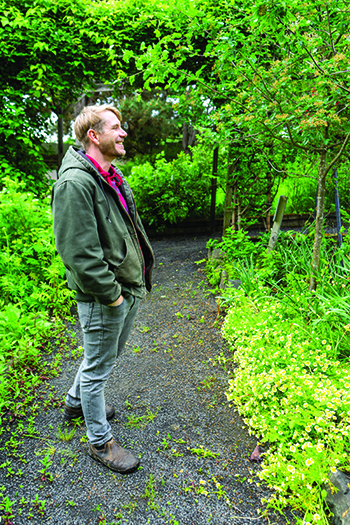 Farmer John Peterson gives a tour of the Pollinate Flowers production garden. The cream-colored flowers to the right are meadowfoam, one of the unique native perennial plants their farm harvests for floral designs.
Farmer John Peterson gives a tour of the Pollinate Flowers production garden. The cream-colored flowers to the right are meadowfoam, one of the unique native perennial plants their farm harvests for floral designs.
John said initially they were interested in growing a “food forest,” a permaculture concept using no-till methods to mimic natural ecosystem layers. “Plants do not grow in isolated environments in nature,” John said. In contrast to traditional row crop market gardening, in a permaculture system different types of plants are established in shared spaces where they can work together and stack functions — trees providing dappled shade for perennial shrubs with ground-level plants at the base.
At first they focused on studying their soil, building fertility and planting food perennials, such as autumn olives. In 2015 they started marketing and selling some of these products but the quantities produced by young perennial food crops weren’t sufficient for the market. And when they did have more volume, the quirky perennial foods weren’t really the kinds people wanted to eat. “Chefs aren’t used to, and consumers don’t want, weird,” John said. “Consumers want normal stuff — broccoli, cauliflower, carrots.”
“The whole business side of the food forest was really challenging to figure out,” he said. “It got to a point where we’d spent all this money and we weren’t really making it back. And, so we either needed to quit doing it or switch directions.”
A farmer, a florist, and a marketer
In 2017, they met Zach Goff, a professional photographer and branding expert. Zach joined the farm team and helped rebrand the farm as it steered in the new direction of growing and selling flowers rather than food. They earned more income from flowers in 2018 than the three previous years’ food crop sales combined.
Their preference for growing unusual perennials alongside some classic annuals helped them develop a unique flower offering while Zach helped shape a distinctive marketing approach to stand out among the competition. They noticed many flower farms used “light and airy” photography and design. “Everything is white and cursive and romantic,” John said. “So, that’s why our website is black and our font is bold and block.” Zach also helped the farm grow its presence on Instagram with quality photographs of the three working in the gardens and showing off finished bouquets. They set up a photo studio in their spare bedroom for professional photographs of Jeremi’s floral designs.
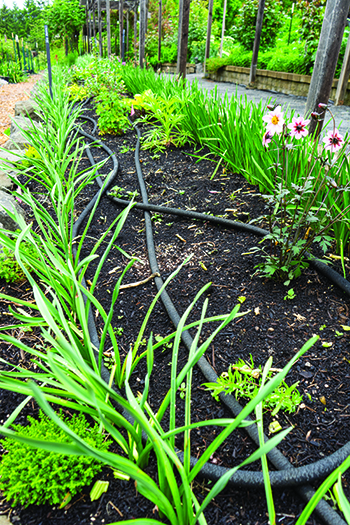 Pollinate Flowers builds garden beds with a deep layer of municipal compost and irrigates using a system of soaker hoses.
Pollinate Flowers builds garden beds with a deep layer of municipal compost and irrigates using a system of soaker hoses.
“Branding is something we’ve realized is very important,” John said. “Now we’re the ‘Pollinate Boys.’ Everyone knows us as that, but that’s because of Zach’s branding us. If they remember our name right, then they know what our website is, and they know how to tell their friend about us.”
Zach’s talents with high-end interior design let him imagine spatial relations in the layout and planting of new beds. “He helps me with conceptualizing how the plants are going to fit together as they grow,” John said.
Meanwhile, in 2018 Jeremi also completed the Certified Floral Designer program at the Floral Design Institute in Portland, Oregon. John said Jeremi developed a distinctive floral style. “His style mimics the natural garden with flowers, textures, and greenery combined to create a cottage garden floral design.”
To learn more about flower growing, harvesting and handling, the farm team looked to Floret Farm’s Online Workshop from Erin Benzakein (former GFM writer), The Flower Farmer by Lynn Byczynski (GFM’s founder), and a wide supportive network of farmers. They set up a flower handling space for Jeremi in the farm’s shop building where they have a walk-in cooler and a large studio for design.
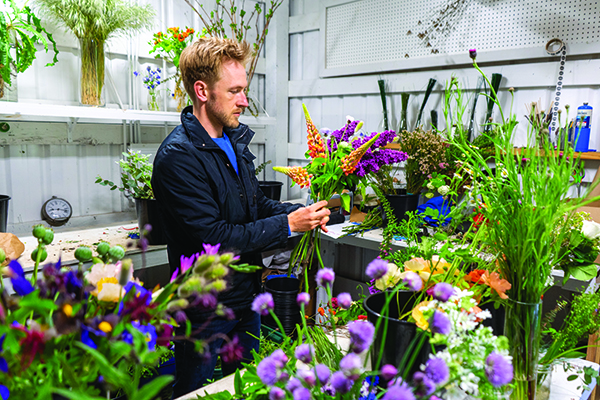 Florist Jeremi Carroll builds a late spring bouquet in his on-farm design studio.
Florist Jeremi Carroll builds a late spring bouquet in his on-farm design studio.
The way the team’s roles clarified during the redirection are consistent today: John is the farmer, with a deep love for the work of planting and tending the land; Jeremi harvests and makes the floral arrangements; and Zach does the bulk of the farm photography and marketing. This combination of skills and roles has helped them maximize income from every stem they grow in their relatively small production garden.
Finding a marketing niche
Since finding their groove as a trio of flower farmers and florists, the “Pollinate boys” have continued to experiment with how and where to market their flowers and bouquets. They offer a bouquet subscription service to the local community and briefly experimented with renting a storefront in nearby Newberg, but found that style of direct market sales isn’t their best niche.
Instead, they have found success with a mixture of wholesale to other florists and commissioned floral design, both allow them to feature their preferred unusual mix of flowers. “We try to grow really interesting cut flowers,” John said. “Everyone grows zinnias. I’m not going to spend a lot of time and energy growing millions of them because at the wholesale market everyone already has them.”
That desire to find their unique niche is what led them to offer more perennials and native plants. In May when I first visited, they had been harvesting a mix of typical annual spring blooms (tulips, daffodils) as well as less traditional items such as rhubarb flowers and Pacific Northwest native meadowfoam and sweet cicely.
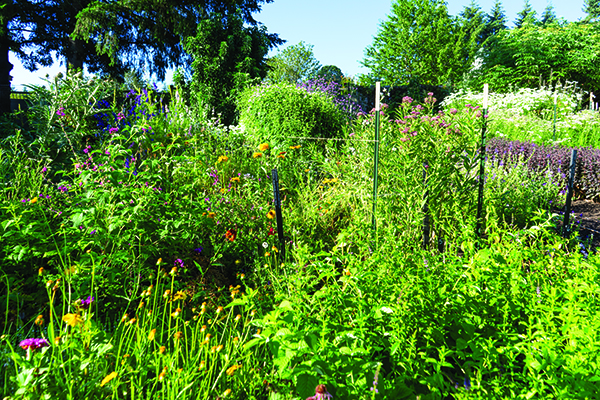
Rhubarb grows next to flowers in the Pollinate Flowers production garden. The Pollinate team is always looking for plants that can offer unique textures and colors to their floral designs.
Jeremi harvests weekly to sell to other florists at their Portland Flower Market booth. They sell out quickly. While at the market, Jeremi also shops for flowers to fill in for his upcoming floral design work. They initially aimed to limit floral design work to plants they’d grown on their farm but found that too restrictive in meeting customers’ needs and offering floral design over a longer season.
“I can’t just say I’m not going to have flowers for four to five months and all we have are dried flowers because that’s what’s in season,” John explained. Buying in some flowers is a small expense that allows them to commit to a client’s vision and offer designs in the shoulder seasons while they still fill out most of the arrangements from the farm.
Besides using as many flowers from the farm as possible, Jeremi also builds sustainability into his floral designs by avoiding disposable flower foams. He uses balled up chicken wire or sustainably foraged moss or straw.
John said they landed in a lucky location for local floral design work. Dundee is a center of Oregon’s wine industry with many associated lodging and dining businesses. There are 100 wineries within a half-hour drive of their farm, many with tasting rooms and event spaces. Pollinate Flowers offers everything from simple bud bouquets for restaurant tables to elaborate wedding displays.
They are pro-active in local business networking communities and get many referrals for wedding and event work. In 2019 they gave free weekly bouquets to many local businesses to display with their business card to help get the word out. Customers choose Pollinate Flowers because they value working with a local business that uses locally grown flowers and appreciate Jeremi’s unique floral design style, John says.
Fine-tuning growing methods
Around the same time the farm team found its footing with marketing, John evolved his permaculture, no-till style of regenerative agriculture by building compost-based deep beds. He spreads about six dump trucks of compost from a municipal composter every year on established and new beds. Replanted beds get broad-forked in the spring before a thick application of compost.
The property’s soil is a heavy clay over bedrock. John finds that using a deep layer of compost on top of their native soil provides fertility and fosters microbial life, but he still tests the soil regularly and amends with micronutrient sources such as lime and kelp meal. “I farm the soil and then I plant plants in it,” he said about his effort in building his garden beds. “In order to have these beautiful, healthy plants, they need to have all of the nutrition in the soil within the first five feet or so, even for perennials.”
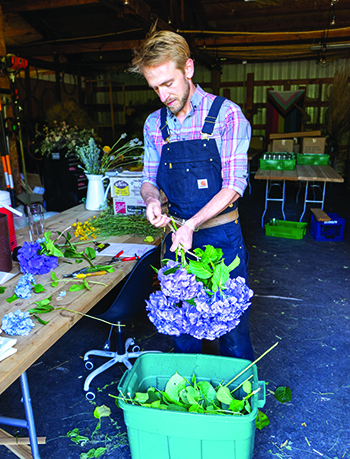 Carroll takes the lead on harvesting flowers both for his own arrangements and to sell to other florists at the Portland Flower Market.
Carroll takes the lead on harvesting flowers both for his own arrangements and to sell to other florists at the Portland Flower Market.
John sees his built beds emulating what happens over time in a forest. “An ancient forest has been around for thousands of years, and it’s had all this time of trees pulling up nutrition from way down in the soil, making the leaves and having them fall. So, you have this layer that’s always slowly decomposing soil, built from the top down.”
His compost beds retain soil moisture well from drip irrigation. Even during last year’s record-setting heat wave in Oregon, his garden beds fared well because of the dappled shade of the overstory plants. “Wherever there was enough shade and filtered sun, all the plants were just fine underneath,” John said. “The flowers and the beds didn’t get droopy until day three when it just didn’t cool off at night.”
His gardens have very little weed and pest pressure, which he attributes to using compost to build beds rather than straw. In his experience, using straw to build beds is challenging in the Pacific Northwest where it can lead to slugs and weed pressure from germinated seeds in the straw itself.
They do have pest pressure in their garden from invasive squirrels and rabbits that live in the overgrown blackberry patch on a neighbor’s property, but they use a pellet gun for control when these animals come into the garden to eat. Otherwise, many animals are welcome in the gardens.
Thirty nest boxes and ten feeders that John maintains invite birds to live on their farm and help control insect-pests. “They are out here 365 days a year from dawn to dusk eating,” John said. They’re especially useful in controlling cucumber beetle populations, he said, adding that one nesting swallow pair will consume 300,000 insects while raising their young from eggs to leaving the nest.
“The kind of habitat we’ve built supports a lot of balance,” John said, reflecting on the healthy plants in their established gardens.
Letting the land and plants lead
Even with the unexpected effects of the pandemic shutdowns, the last two years have been some of the best for Pollinate Flowers. The pandemic provided incentive for Jeremi to also work full-time on the farm after his prior employer closed down temporarily. They had saved money and took the leap away from off-farm income.
As part of the experiment with a new level of farming in 2020 and 2021, they hired employees to increase their scale of production. But their growing and designing philosophy was challenging for some employees who wanted a clearly planned vision for the season at the beginning of the year.
“I just roll with the season based on what’s happening in the garden,” John said. “I don’t want to base my decisions on a plan I made in December or January. I’m learning this about myself — I’m not a spreadsheet farmer.”
John describes himself as very observational, in contrast to Jeremi and other farmers whom he describes as “doers.” “I’m slower in my process because I spend a lot of time watching things, especially in the summer,” John said. “I spend a lot of time observing how the plants move around in the garden, which helps me understand where to put certain plants and what they want to be happy.”
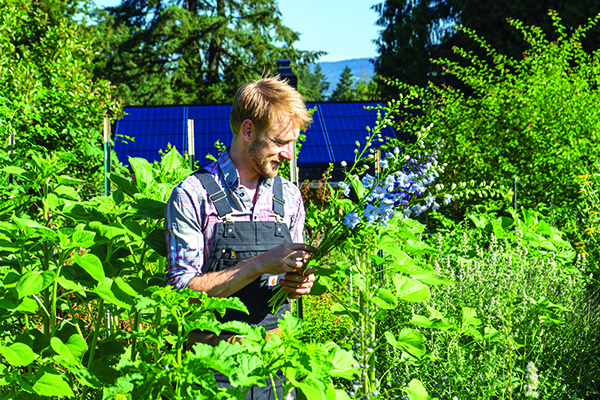 Jeremi Carroll harvests delphinium to sell as cut stems to other florists at the Portland Flower Market.
Jeremi Carroll harvests delphinium to sell as cut stems to other florists at the Portland Flower Market.
Sustainability is a driving goal. During tours, John showed me the beauty of his favorite cut flowers, but he also guided me to the back edges where he has spent valuable time and energy planting native plants that serve no purpose beyond the wider ecosystem of their farm and surrounding area. He has dragged logs below fir trees and planted shade-loving native plants, all with the hope of creating more biodiversity.
“In the summertime, the ground underneath the logs stays wet longer than the ground around it,” John explained. “We’re thinking about ‘what is a forest? What does a forest look like?’ Then we try to replicate that around the fringes of our production space.” His long-term goal is to create a circle of nutrition.
He relishes the constant experimenting and the time spent investing in seemingly small details and then appreciating the measurable shifts in biodiversity and ecosystem benefits in their small acreage. He expresses continual trust in natural processes and sees his work as an extension of those processes.
John also hopes to model that possibility for other growers. “We want to encourage other farmers to focus on the soil and create a 12-month habitat for living things,” John said. He points to choices such as building soil “from the top down,” removing chemicals from production systems, leaving roots in the ground year-round, minimizing soil compaction from machinery, and working with the natural cycles of crops and weather as examples of how they try to view their farm plot as “one interconnected/holistic system.” He sees this approach as having wide benefits, both for the ecosystem and the farm business.
Ultimately, John said, “The goal is less work and more success for the farmer.”
Update: since this article was written, Pollinate has decided to sell their farm/house in order to create a more manageable business model for themselves in another location. Here’s a link to the listing in case anyone is interested: tinyurl.com/2s3j7fxj.
Katie Kulla lives and farms with her family in Yamhill County, Oregon. She is currently writing a book about farming and parenting and wants to hear from other farm families! Connect with Katie at KatieKulla.com and on Instagram: @katiekulla.
